by Kevin Siegel, Communications Manager, HELUKABEL USA and Marsha Wolf, Astronomer-RSS-NIR Principal Investigator, University of Wisconsin-Madison
While infrared imagers have been in use on telescopes for some time, spectrographs that split the light into a spectrum of separate wavelengths have been slower in coming. With such instruments, astronomers can survey extremely faint objects across the universe because infrared wavelengths permit light to pass through dust that surrounds otherwise hidden, super-massive black holes or newly forming stars inside dense gas clouds. The infrared universe reveals answers to many questions of star and galaxy formation and evolution.
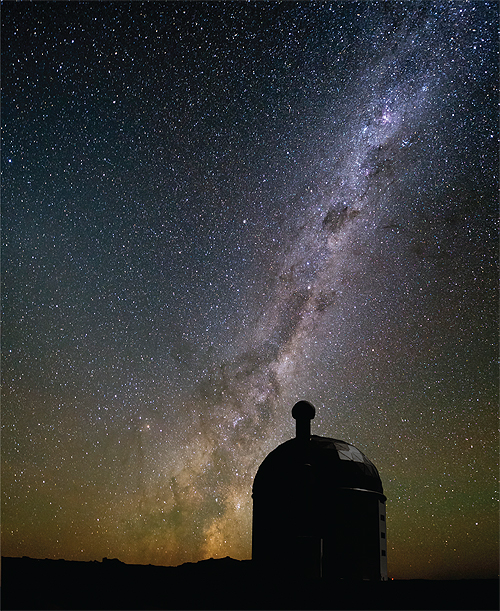
Southern African Large TelescopeSouthern (SALT) in the Karoo Desert of South Africa Photo credit: >Kevin Crause
One of the challenges with astronomical observations in infrared light is that all objects, including the instrument itself, emit infrared radiation. The amount of infrared emission goes up with the object’s temperature. This thermal radiation shows up in an astronomical image as contaminating background light that did not come from the source object. For faint objects that astronomers want to observe, the background from even a room temperature instrument can be larger than the signal from the target object, rendering it undetectable. Thus, to decrease instrument thermal background contamination, components must be cooled to very low temperatures.
The University of Wisconsin-Madison (UW) is building an infrared astronomical instrument called the Robert Stobie Spectrograph Near Infrared Arm (RSS-NIR). Its home will be the 11-m (~36-ft) diameter Southern African Large Telescope (SALT) in the Karoo Desert of South Africa. The RSS-NIR will operate at near infrared wavelengths out to 1700 nanometers.
Its components exist in compartments that have three operating temperatures. The initial optical equipment operates at -10° C to +25° C (14° F to 77° F). After a dichroic, or two-color, element splits the visible and infrared light, the remaining parts are enclosed by an insulated box called a pre-dewar and maintained at -40° C (-40° F). Within that enclosure is a cryogenic dewar operating at -150° C (-238° F) containing the infrared detector that records the images. The pre-dewar enclosure houses mechanisms that configure the instrument for different observation modes. The moving components in the RSS-NIR contain motors, position sensors and encoders, temperature sensors, and heaters for thermal stability control, all of which require wires running between them and the external control system.
Heat leaking through or around electrical connectors will raise thermal gradients in the instrument, which amplify the background infrared radiation and increase the load on the pre-dewar cooling system. Humid air leaking through or around electrical connectors condenses on the cold optics inside the pre-dewar and damages optical coatings. To mitigate these effects, the team had to minimize the number of cable penetrations into the pre-dewar from the external controls enclosure.
Another challenge: electrical cables inside the pre-dewar must be routed to ensure the moving mechanisms full range of motion. The cold operating environment of the pre-dewar and bending/flexing requirements put stringent constraints on the types of cables that can be used. The insulation must remain electrically functional at -40° C (-40° F), yet cannot become so stiff or brittle as to inhibit bending and flexing motions.
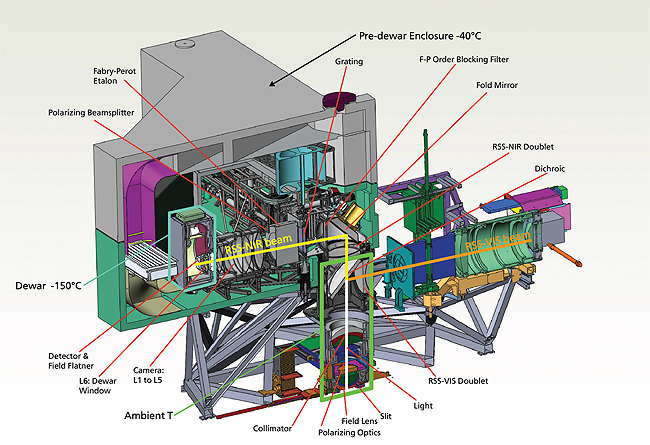
Light from the telescope comes up from below to an image plane at the bottom component labeled “slit.” It then passes through a series of optical elements that collimate the light. At the element labeled “dichroic,” the light is split by colors into visible and infrared wavelengths. Visible light goes to the RSS-VIS instrument to the right, and infrared light goes up into the RSS-NIR
Thus, sensors and drivers inside were selected and designed to communicate over serial networks. A 1-wire™ network developed by Dallas Semiconductor™ and acquired by Maxim™ is used to serialize temperature, humidity, hall proximity, mass air-flow, and air pressure sensors. Digital I/O that detects limit switches and drives solenoids also live on this network. The network does not require controlled impedance cables or resistive terminators, since it is limited by the total capacitance of the network. This allows topology flexibility by allowing short stubs consisting of separate power conductors and data lines.
The RSS-NIR development team approached HELUKABEL USA for a cabling solution. Ron Koch, SSEC electrical engineer who designed the RSS-NIR control hardware chose the HELUKAT® Industrial Ethernet cable (P/N 82838), which is a twisted quad, copper data cable. The quad design lays more efficiently than two pairs, resulting in a smaller cable diameter and as such, a smaller bend radius. Furthermore, the cable is designed for continuous flex applications having a low friction wrap between the wires and braided shield enclosed within a PUR jacket capable of performing in the cold temperatures of the pre-dewar.
Koch has continued to consult with HELUKABEL USA to incorporate additional products:
- DeviceNet™ PUR cable for a CANbus network to communicate with absolute linear encoders.
- Industrial USB BUS S cable to transmit RSS-NIR image data.
- SUPER-PAAR-TRONIC-C-PUR, which is connected to the RFID antenna to identify the filters and gratings in the instrument.
- DATAPUR®-C and SUPERTRONIC-C-PURö control and motor cables.
The SALT with the combined RSS-NIR and RSS-VIS is expected to be fully operational by 2015.
HELUKABEL USA
www.helukabel.com
Filed Under: Cables + cable management, Encoders • linear

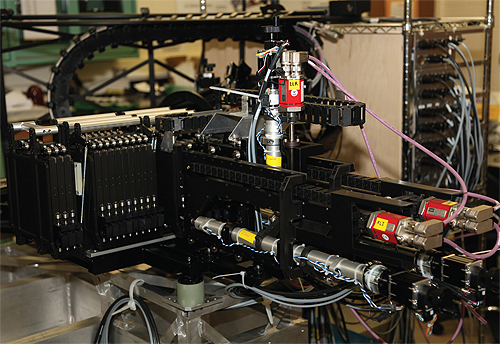
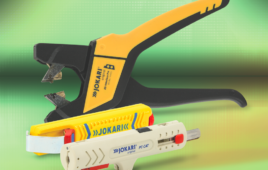
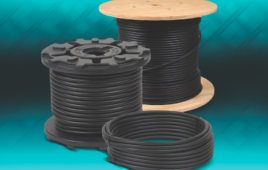
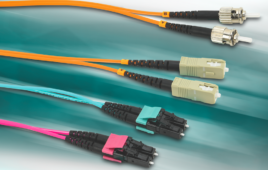
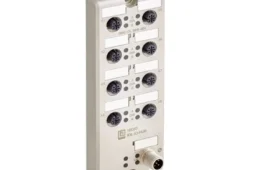
Tell Us What You Think!